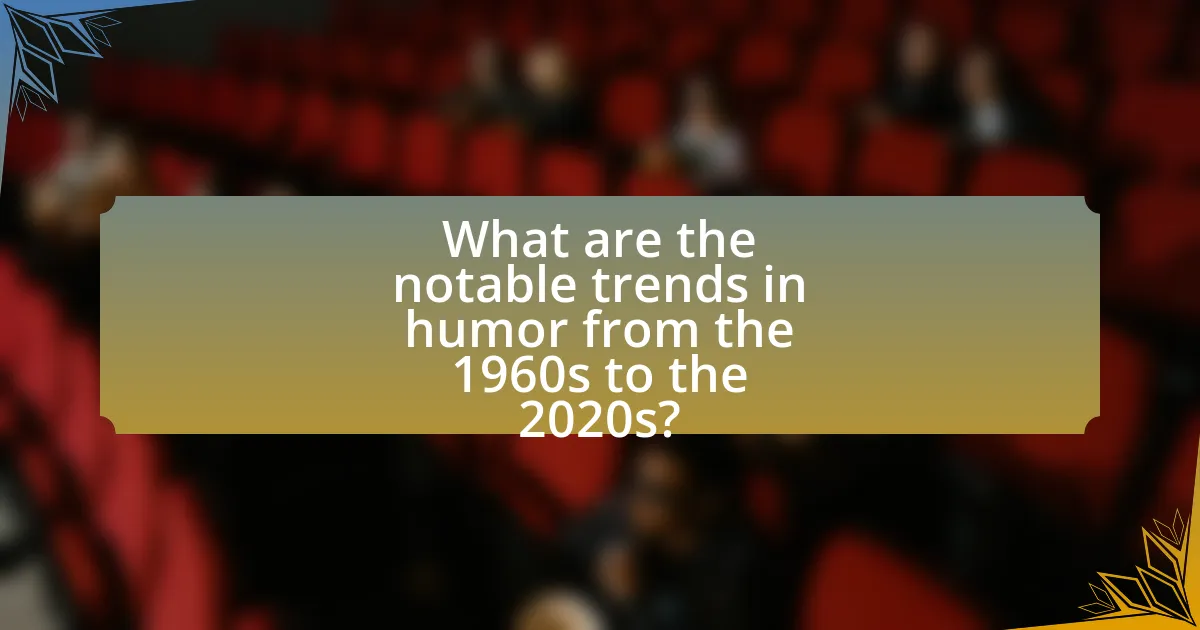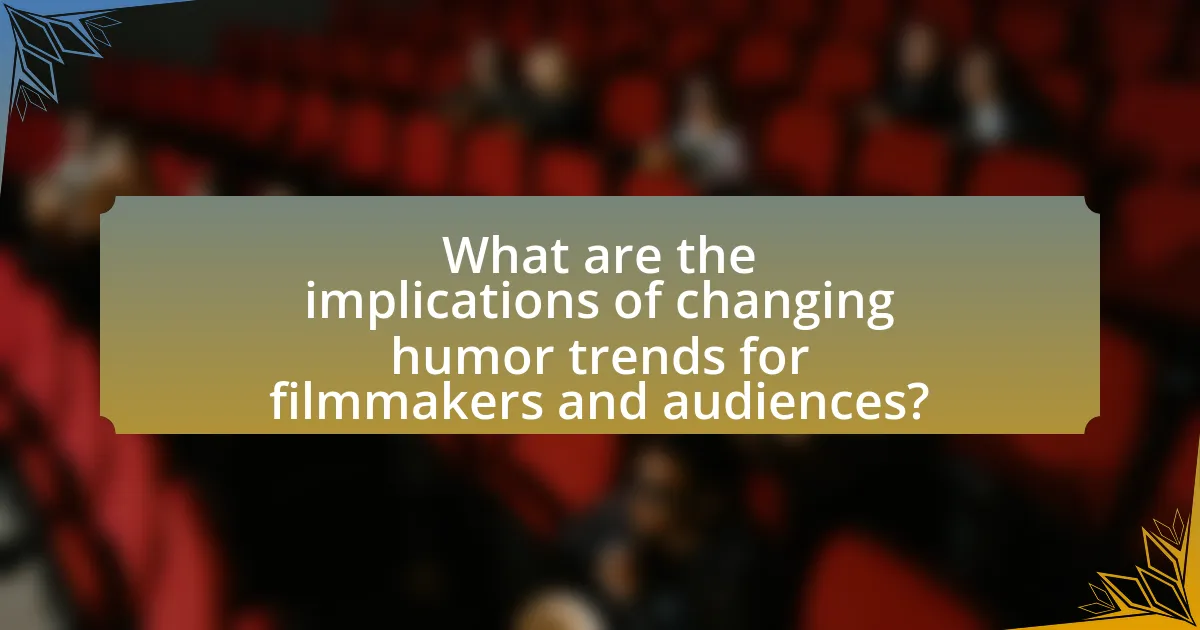The article “Comedy Through the Decades: A Look at Changing Humor Trends in Film” examines the evolution of comedic styles in film from the 1920s to the present. It highlights key characteristics of comedy across different decades, including the transition from silent films with physical humor to the incorporation of satire, romantic comedies, and digital media influences. The article also explores how cultural factors, societal norms, and technological advancements have shaped comedic content, as well as the emergence of various comedic genres. Additionally, it discusses the impact of political and social movements on humor, the role of streaming services in diversifying comedic expression, and the implications of changing humor trends for filmmakers and audiences.

What are the key characteristics of comedy in film throughout the decades?
The key characteristics of comedy in film throughout the decades include evolving humor styles, cultural references, and technological advancements. In the 1920s and 1930s, silent films relied heavily on physical comedy and visual gags, exemplified by Charlie Chaplin and Buster Keaton. The 1940s and 1950s introduced witty dialogue and situational comedy, as seen in films like “His Girl Friday.” The 1960s and 1970s embraced satire and social commentary, with movies such as “Dr. Strangelove” reflecting contemporary issues. The 1980s and 1990s saw the rise of romantic comedies and ensemble casts, highlighted by films like “When Harry Met Sally.” In the 2000s and beyond, comedy has increasingly incorporated digital media and diverse storytelling, as evidenced by the success of streaming platforms and shows like “The Office.” Each decade’s comedic style reflects societal changes, audience preferences, and technological innovations, demonstrating the dynamic nature of humor in film.
How has the definition of comedy evolved over time?
The definition of comedy has evolved from its origins in ancient Greek theater, where it was primarily a form of entertainment that involved exaggerated characters and situations, to a more nuanced understanding that encompasses various styles and cultural contexts. In ancient Greece, comedy was characterized by its focus on social satire and the absurdity of human behavior, as seen in the works of playwrights like Aristophanes. Over time, during the Renaissance, comedy began to incorporate elements of romantic entanglements and misunderstandings, as exemplified by Shakespeare’s comedies.
In the 20th century, the advent of film introduced new comedic forms, such as slapstick and situational comedy, which relied on visual gags and timing, as demonstrated by silent film stars like Charlie Chaplin and Buster Keaton. The late 20th and early 21st centuries saw the rise of stand-up comedy and sitcoms, which often address contemporary social issues and personal experiences, reflecting a shift towards more relatable and character-driven humor. This evolution illustrates how comedy has adapted to cultural changes and audience expectations, making it a dynamic and ever-changing art form.
What cultural factors have influenced the evolution of comedic styles?
Cultural factors such as societal norms, historical events, and technological advancements have significantly influenced the evolution of comedic styles. For instance, the rise of the silent film era in the early 20th century emphasized physical comedy and visual gags due to the lack of sound, as seen in the works of Charlie Chaplin and Buster Keaton. Additionally, the social upheaval during the 1960s, including the civil rights movement and counterculture, led to the emergence of satire and stand-up comedy that challenged authority, exemplified by comedians like George Carlin and Richard Pryor. Furthermore, the advent of television in the mid-20th century allowed for diverse comedic formats, such as sketch shows and sitcoms, which reflected and shaped public attitudes, as demonstrated by shows like “Saturday Night Live.” These cultural factors collectively illustrate how comedy adapts to and reflects the zeitgeist of its time.
How do societal norms shape comedic content in different eras?
Societal norms significantly shape comedic content in different eras by influencing the themes, styles, and subjects that comedians and filmmakers choose to explore. For instance, during the 1920s and 1930s, comedy often reflected the societal values of the time, such as the pursuit of the American Dream, as seen in the works of Charlie Chaplin and the Marx Brothers. In contrast, the 1960s and 1970s introduced more countercultural humor, addressing issues like civil rights and anti-establishment sentiments, exemplified by shows like “Laugh-In” and the films of Mel Brooks.
Moreover, the evolution of societal attitudes towards topics such as gender, race, and sexuality has led to shifts in comedic content. For example, the rise of feminist comedy in the 1980s and 1990s, represented by figures like Joan Rivers and Ellen DeGeneres, challenged traditional gender roles and stereotypes. Similarly, the acceptance of LGBTQ+ themes in comedy has grown, with shows like “Will & Grace” and “Schitt’s Creek” reflecting changing societal attitudes.
These shifts illustrate how comedians adapt their material to resonate with contemporary audiences, ensuring that humor remains relevant and reflective of the prevailing cultural landscape.
What are the major comedic genres that emerged in each decade?
The major comedic genres that emerged in each decade include slapstick in the 1920s, screwball comedy in the 1930s, film noir comedy in the 1940s, absurdist comedy in the 1950s, satire in the 1960s, dark comedy in the 1970s, romantic comedy in the 1980s, and mockumentary in the 1990s. Each genre reflects the cultural and social contexts of its time, with slapstick characterized by physical humor and visual gags, screwball comedy featuring fast-paced dialogue and romantic entanglements, and film noir comedy blending humor with crime and cynicism. The 1950s saw the rise of absurdist comedy, challenging conventional narratives, while the 1960s’ satire critiqued societal norms. Dark comedy in the 1970s tackled taboo subjects with humor, romantic comedies of the 1980s focused on love and relationships, and the 1990s’ mockumentary style parodied traditional documentary filmmaking. These genres illustrate the evolution of comedic styles and societal reflections throughout the decades.
Which films exemplify the defining comedic genres of the 1920s?
The films that exemplify the defining comedic genres of the 1920s include “The Kid” (1921) by Charlie Chaplin, “Safety Last!” (1923) featuring Harold Lloyd, and “The Gold Rush” (1925), also by Chaplin. These films represent the silent film era’s slapstick and situational comedy, showcasing physical humor and emotional depth. “The Kid” combines comedy with poignant themes of poverty and parenthood, while “Safety Last!” is renowned for its iconic clock-hanging scene, illustrating the era’s fascination with daring stunts. “The Gold Rush” features Chaplin’s Tramp character in humorous yet challenging situations, highlighting the blend of comedy and social commentary prevalent in 1920s cinema.
How did the rise of television impact comedy films in the 1950s?
The rise of television in the 1950s significantly impacted comedy films by shifting audience preferences towards shorter, episodic content. As television became a dominant form of entertainment, it provided a platform for comedic performances that were more accessible and frequent than feature-length films. This led to a decline in box office attendance for comedy films, as viewers opted for the convenience of watching comedy shows at home. For instance, popular television comedies like “I Love Lucy” attracted large audiences, demonstrating the shift in comedic consumption. Consequently, filmmakers began to adapt their styles, often incorporating elements that mirrored television’s pacing and humor to compete effectively.

What are the notable trends in humor from the 1960s to the 2020s?
Notable trends in humor from the 1960s to the 2020s include the evolution from slapstick and situational comedy to more diverse and nuanced forms of humor, such as dark comedy and satire. In the 1960s, humor often relied on physical comedy and absurdity, exemplified by shows like “The Dick Van Dyke Show.” The 1970s introduced more socially conscious humor, as seen in “MAS*H,” which tackled serious issues through comedy. The 1980s and 1990s saw the rise of stand-up comedy and sitcoms that focused on character-driven narratives, with shows like “Seinfeld” emphasizing observational humor.
In the 2000s, humor began to incorporate internet culture and meme-driven content, reflecting a shift towards rapid-fire jokes and self-referential humor, as seen in “The Office.” By the 2010s and 2020s, humor increasingly embraced diversity and inclusivity, with platforms like Netflix showcasing a wide range of comedic voices, including those from marginalized communities. This period also saw the rise of political satire, with shows like “Saturday Night Live” and “Last Week Tonight with John Oliver” addressing current events with sharp wit. Overall, humor has transitioned from traditional formats to more varied and complex expressions, reflecting societal changes and technological advancements.
How did political and social movements influence comedy in the 1970s?
Political and social movements significantly influenced comedy in the 1970s by introducing themes of social justice, anti-establishment sentiments, and cultural critique. The civil rights movement, feminist movement, and anti-war protests prompted comedians to address issues like racism, sexism, and government authority, leading to a more satirical and confrontational style of humor. For instance, shows like “All in the Family” tackled racial and social issues head-on, reflecting the changing societal landscape. Additionally, comedians such as George Carlin and Richard Pryor used their platforms to challenge societal norms and provoke thought, demonstrating how comedy became a vehicle for political commentary during this transformative decade.
What role did satire play in the comedy films of the 1980s?
Satire played a crucial role in the comedy films of the 1980s by providing a sharp critique of social norms, politics, and popular culture. Films like “Airplane!” and “The Naked Gun” utilized absurdity and parody to highlight the ridiculousness of contemporary issues, effectively engaging audiences while provoking thought. This era saw a rise in films that not only entertained but also challenged viewers to reflect on societal absurdities, as evidenced by the success of satirical comedies that often topped box office charts and received critical acclaim. The integration of satire in these films contributed to a broader cultural conversation, making humor a vehicle for social commentary during the decade.
How did the advent of the internet change comedic expression in the 2000s?
The advent of the internet fundamentally transformed comedic expression in the 2000s by enabling rapid dissemination and democratization of humor. Online platforms like YouTube, social media, and blogs allowed comedians to reach global audiences without traditional gatekeepers, leading to diverse comedic styles and voices emerging. For instance, viral videos and memes became significant forms of comedy, exemplified by the popularity of content creators like Jenna Marbles and the rise of meme culture, which often relied on shared cultural references and real-time engagement. This shift not only expanded the types of humor available but also influenced mainstream comedy, as traditional media began to incorporate internet-driven humor into television and film, reflecting the changing landscape of audience preferences.
What are the recurring themes in comedy films from the 1990s to today?
Recurring themes in comedy films from the 1990s to today include the exploration of identity, social norms, and relationships. Identity themes often focus on personal growth and self-discovery, as seen in films like “The Birdcage” (1996) and “Mean Girls” (2004), which address issues of gender and social acceptance. Social norms are frequently challenged, with films such as “Bridesmaids” (2011) and “The Hangover” (2009) highlighting the absurdities of contemporary life and friendship dynamics. Additionally, relationship dynamics, including romantic entanglements and familial bonds, are central to many comedies, as evidenced by “Crazy, Stupid, Love” (2011) and “The 40-Year-Old Virgin” (2005), which explore love and companionship in humorous contexts. These themes reflect societal changes and the evolving landscape of humor over the decades.
How has the representation of gender and race evolved in modern comedies?
The representation of gender and race in modern comedies has evolved significantly to reflect greater diversity and inclusivity. Historically, comedies often relied on stereotypes, with limited roles for women and people of color. However, recent trends show a shift towards complex characters and narratives that challenge traditional norms. For instance, films like “Crazy Rich Asians” and “The Other Woman” feature strong female leads and diverse casts, highlighting the importance of representation in storytelling. Additionally, shows like “Insecure” and “Brooklyn Nine-Nine” incorporate racial and gender diversity in their humor, addressing social issues while entertaining audiences. This evolution indicates a broader cultural recognition of the need for varied perspectives in comedic narratives, aligning with societal movements advocating for equality and representation.
What impact has streaming services had on comedy film production?
Streaming services have significantly transformed comedy film production by increasing accessibility and diversifying content. These platforms, such as Netflix and Amazon Prime, have enabled a broader range of comedic voices and styles to emerge, allowing for niche comedies that may not have found support in traditional theaters. For instance, Netflix’s investment in original content has led to the production of films like “The Lovebirds” and “Eurovision Song Contest: The Story of Fire Saga,” which cater to varied comedic tastes. Additionally, streaming services have shifted the release model, allowing for immediate global distribution, which has resulted in a more competitive landscape for comedy films. This change is evidenced by the rise in viewership and engagement metrics, as audiences increasingly turn to streaming for their entertainment needs.

What are the implications of changing humor trends for filmmakers and audiences?
Changing humor trends significantly impact filmmakers and audiences by influencing content creation and viewer engagement. Filmmakers must adapt their comedic styles to align with contemporary societal norms and preferences, as evidenced by the shift from slapstick to more nuanced humor reflecting cultural sensitivities. For instance, the rise of streaming platforms has led to diverse comedic voices, allowing for niche genres that resonate with specific demographics, thereby expanding audience reach. Audiences, in turn, experience a broader range of comedic expressions, which can enhance their viewing experience but may also lead to polarization as humor becomes more tailored to particular social groups. This dynamic necessitates that filmmakers remain attuned to evolving tastes to maintain relevance and connect with viewers effectively.
How can filmmakers adapt to shifting comedic tastes?
Filmmakers can adapt to shifting comedic tastes by actively researching audience preferences and incorporating diverse humor styles that resonate with contemporary viewers. For instance, the rise of social media has influenced comedic timing and content, leading filmmakers to integrate relatable, meme-inspired humor that appeals to younger demographics. Additionally, analyzing box office trends and audience feedback can provide insights into successful comedic elements, as seen in the popularity of films like “Crazy Rich Asians,” which showcased culturally specific humor while appealing to a broad audience. By staying attuned to cultural shifts and experimenting with innovative comedic formats, filmmakers can effectively align their work with evolving comedic sensibilities.
What strategies can be employed to create relatable humor in contemporary films?
Contemporary films can create relatable humor by employing strategies such as observational comedy, character-driven narratives, and situational irony. Observational comedy focuses on everyday experiences and common social interactions, making humor accessible to a broad audience. Character-driven narratives allow for the development of relatable characters whose flaws and quirks resonate with viewers, enhancing the comedic effect. Situational irony, where the outcome is contrary to what is expected, can also elicit laughter by highlighting the absurdities of life. These strategies are effective because they tap into shared experiences and emotions, making the humor feel authentic and relevant to the audience.
How can understanding historical trends enhance comedic writing?
Understanding historical trends enhances comedic writing by providing context and relevance to humor, allowing writers to tap into societal norms and values that resonate with audiences. For instance, comedy from the 1920s often reflected the post-World War I disillusionment, while the 1980s humor frequently addressed the rise of consumerism and technology. By analyzing these trends, comedic writers can craft jokes and narratives that align with contemporary issues or evoke nostalgia, making their work more relatable and impactful. Historical context also aids in recognizing what has been successful or failed in the past, guiding writers in their creative processes.
What lessons can audiences learn from the evolution of comedy in film?
Audiences can learn that the evolution of comedy in film reflects societal changes and cultural norms over time. For instance, early silent films relied heavily on physical humor and slapstick, as seen in Charlie Chaplin’s works, which highlighted the struggles of the working class during the industrial era. As sound was introduced, dialogue-driven comedies emerged, showcasing the importance of wit and character development, exemplified by films like “Bringing Up Baby” in the 1930s. Furthermore, the rise of social commentary in the 1960s and 1970s, as demonstrated in films like “The Graduate,” illustrates how comedy can address serious issues, such as generational conflict and societal expectations. This progression teaches audiences that humor is not static; it evolves in response to cultural shifts, allowing for both entertainment and reflection on contemporary issues.
How can viewers appreciate the context behind different comedic styles?
Viewers can appreciate the context behind different comedic styles by understanding the historical, cultural, and social influences that shaped them. For instance, slapstick comedy emerged in the silent film era, reflecting the physicality of performance due to the absence of sound, while satire gained prominence during political upheavals, allowing comedians to critique societal norms. Recognizing these influences helps viewers grasp why certain styles resonate in specific eras, such as the rise of dark humor during times of crisis, which serves as a coping mechanism. This contextual awareness enhances the viewing experience by providing insight into the motivations and societal commentary embedded within various comedic forms.
What are the best practices for engaging with comedy films across decades?
To effectively engage with comedy films across decades, viewers should consider the historical context, cultural references, and evolving humor styles. Understanding the societal norms and issues of each era enhances appreciation for the comedic elements, as humor often reflects contemporary values and challenges. For instance, the slapstick comedy of the 1920s contrasts sharply with the satirical and self-referential humor of the 2000s, illustrating how comedy adapts to changing audience sensibilities. Engaging with film critiques and analyses can also provide deeper insights into the comedic techniques employed, such as timing, delivery, and character archetypes, which have evolved over time.


